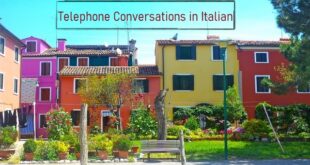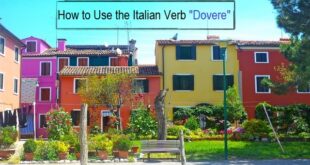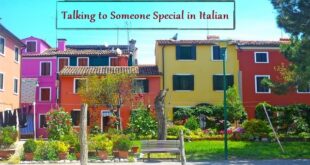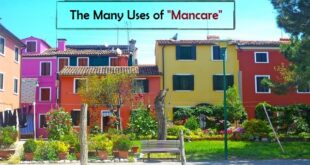Italian Telephone Phrases to Use with Friends Once one is in Italy to visit relatives or friends, and especially for business, it is important to know both the familiar and polite Italian phrases used to initiate a telephone conversation. When making a telephone call to a friend, two common greetings are used, depending on how well the friends know each other. Pronto. Sono Caterina. Ready. (for hello) I am Kathy. Pronto. Sono io! Ready. (for hello) It’s me! (lit. It is I!) In some households in Italy, landlines are still in use. In this case, of course, one needs …
Read More »Using the preposition “su”
“Su” in reference to a place: Physical Position: “On” “On top of” The Italian preposition “su” means “on“ and provides a literal description of one’s physical location or movement upward. The concept is simple: if someone or something is “on” something, it is above that thing, often connected to it in some way, but usually able to be removed and repositioned. As with other prepositions, su is combined with the definite article for the noun that follows and in this case, describes what the subject is “on.” The combination means, “on the” or “on top of the.” Of course, an …
Read More »How to use the verb “dovere”
The Italian verb dovere fills an essential role in everyday life, whether one is a traveler to Italy or is speaking to an acquaintance, friend, or family. Dovere is used as a helping verb to emphasize the obligation or the need to complete an action with its meanings of “to have to,” or “to must.” Think of how many times a day we say we “have to” or “must” do something — leave for work or school, run an errand, meet a friend we haven’t seen in a while — the permutations are endless! Also, it is important to note …
Read More »Talking About Emotions (2)
Talking about one’s emotions is complex, both in one’s native language and certainly in an adopted language. In Italian, many phrases used to convey emotion are idiomatic, and the choice of verbs can differ with even minor differences in a situation. For instance, an upcoming event may make one happy and generate positive feelings of excitement and anticipation. Although it is nice to have something to look forward to (as we discussed in Part 1 of this series about emotions last year), given the repetitiveness of daily life, we all feel bored at one time or another. It is a …
Read More »Talking to someone special
Meeting someone at a gathering — Piacere di conoscerla… Where do two people who form a lasting relationship have their first encounter? Many times soon-to-be couples are introduced by a friend, often at a festa (party). The Italian verb conoscere is used when two people first meet. In a previous blog, The Holidays in Italy, we discussed the many variations of friendly Italian introductions, and the most common reply, “Piacere di conoscerla,” for, “It is a pleasure to meet you.” This phrase uses the formal “la” to mean “you.” More commonly, though, and especially at informal gatherings of young people, the familiar …
Read More »“Dare” and verbs of giving
The Italian verb dare is most often used with the meaning “to give,” or literally, “to hand over” something to someone else. When the object “handed over” is a gift, dare may be used to describe this action or the more specific verbs of gift-giving may come into play, such as regalare (to give a gift) and donare (to donate). To truly sound like a native Italian, learn the quintessential Italian interjection, “Dai!” from the second person conjugation of dare. The Italian verb dare is also an integral part of an important Italian expression, “dare del tu,” which allows one to …
Read More »Christmas giving in Italy
We’ve discussed Italian Christmas traditions in December each year since this blog’s inception. As noted before, the Christmas season in Italy lasts from the beginning of December until after the New Year. Below are the important dates to remember for those celebrating Christmas in Italy, along with Italian greetings for each holiday. To follow is the story of La Befana, the friendly Italian witch with gifts for all. The Italian Christmas Season L’Immacolata Feast of the Immaculate Conception: Catholic holiday that celebrates mother Mary. La Vigilia di Natale Il Natale Christmas Eve Christmas Buon Natale! Buone Feste! Merry Christmas! Happy …
Read More »Expressing Emotion in Italian
Expressing one’s emotions is complex, both in one’s native language and certainly in an adopted language. In Italian, many phrases used to convey emotion are idiomatic, and the choice of verbs can differ with even minor differences in a situation. This is especially true for the winter holiday season, which brings with it happiness and anticipation, and many ways to express these feelings in Italian! In short, we must learn to think in Italian if we are to communicate our emotions in Italian! Expressing Happiness in Italian — Contento, Felice, Piacere Sono contento(a) di… If an Italian is happy, he …
Read More »Italian family conversations
The Italian Family of Yesterday and Today Traditionally, married couples in Italy had large families and raised their children as part of an extended family of aunts, uncles, and cousins. In modern Italy, nuclear families tend to be smaller, but the language for how to describe children as they grow from a baby to an adult has not changed very much. Young boys and girls are called “the baby” — with “il bambino” for young boys or “la bambina” for young girls — until 5 or 6 years, long after we Americans would consider the “baby stage” has been completed. …
Read More »The many uses of mancare
The Italian verb mancare has many meanings: to miss (someone)/to need (something)/to lose/to lack/to be lacking/to omit/to fail and can even be used as a euphemism for to die. Perhaps the most common way Italians use the verb mancare is to convey the idea of “to miss someone,” which was discussed in detail in a previous blog in this series, ” ‘Missing You’ with Mancare” In the prior blog, the conjugation of mancare and the use of indefinite object pronouns needed to convey the idea of “missing someone” was discussed in detail. With this blog, we will now focus on the …
Read More » Fra Noi Embrace Your Inner Italian
Fra Noi Embrace Your Inner Italian











